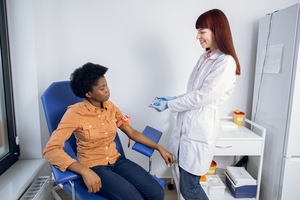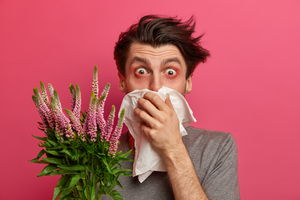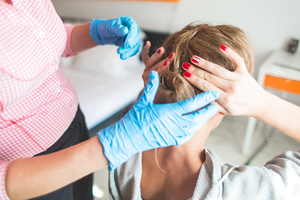Chemical Peels
Chemical peels and your skin
According to the Cleveland Clinic, a chemical peel, also known as a face peel or skin peel, is a skin treatment that uses a topical chemical applied to the surface of your facial skin to remove damaged skin cells. After your skin peels off, the skin that grows underneath is usually brighter, tighter, and more rejuvenated. Chemical peel benefits include improving several skin conditions, like acne, melasma, wrinkling, and sun damage.
Who is a good candidate for a chemical peel?
For example, to be a candidate for a chemical peel, you mustn’t take the medication known as Accutane for at least six months before the procedure, note the Cleveland Clinic. A good candidate is also someone who does not have a history of skin scarring, highly sensitive skin, or the inability to stay out of the sun during the healing period. According to the Cleveland Clinic, chemical peels can be performed on all skin types. However, people with darker skin pigments have a higher risk of skin discoloration after a chemical peel.
Before you get a chemical peel
You may need to follow a specific skincare routine two to four weeks before getting a chemical peel. According to the American Academy of Dermatology (AAD), this can help reduce your potential for side effects and improve the success of your treatment. It will be necessary for your medical provider to know about any medications you take, especially those for skin conditions, like topical retinol. These medications must be avoided for some time before the treatment.
How chemical peels are done
A chemical peel is usually done on an outpatient basis, meaning that you can go home the same day of the procedure. A dermatologist will first clean your skin and ensure that you are comfortable. A dermatologist may also apply a numbing medicine to the surface of your skin. In addition to these steps, deep peels will require sedation via intravenous medication and surveillance with a heart rate monitor, notes the AAD.
After the preparation period, a dermatologist will apply a chemical solution to the skin of your face. This may sting or burn. After several minutes, the chemical solution is removed or neutralized. You may feel sunburned skin, but cool compresses can help, according to the AAD.
What to expect after the chemical peel
After a chemical peel, you will need to have someone else drive you home, especially if you have been sedated. In addition, you may need to take pain medications and continue using cool compresses while your skin heals. According to the AAD the recovery process for your chemical peel will vary depending on the type of peel you received.
- For light peels, the AAD notes that you may experience redness and scaling, and it may take 1 to 7 days for your skin to recover. It will be important that you moisturize and use sunscreen during this time. You may need to schedule follow-up peels to achieve a complete result.
- For medium peels, the AAD notes that you may experience swelling, blisters, and crusting, and it may take 7 to 14 days for your skin to recover. During this time, it will be important that you soak your skin, use a specific ointment, avoid the sun, and take antiviral medicine. You may discuss with your dermatologist a timeline for when you may want a follow-up peel to maintain results.
- For deep chemical peels, the AAD notes you may experience redness, swelling, blistering, crusting, and discomfort, and it may take 14 to 21 days for your skin to recover. During this time, it will be important that you do several soaks a day, apply ointment and moisturizer, and take antiviral medicine. You will also need to completely avoid the sun for 3 to 6 months. According to the AADit is not advisable to have more than one deep peel.
The AAD recommends making sure to follow your dermatologist’s instructions for skin care after your peel. The extent to which you can follow these guidelines can dramatically influence the appearance and quality of your skin after the procedure.
Find Chemical Peels near you
- Alabama
- Alaska
- Arizona
- Arkansas
- California
- Colorado
- Connecticut
- Delaware
- Florida
- Georgia
- Hawaii
- Idaho
- Illinois
- Indiana
- Iowa
- Kansas
- Kentucky
- Louisiana
- Maine
- Maryland
- Massachusetts
- Michigan
- Minnesota
- Mississippi
- Missouri
- Montana
- Nebraska
- Nevada
- New Hampshire
- New Jersey
- New Mexico
- New York
- North Carolina
- North Dakota
- Ohio
- Oklahoma
- Oregon
- Pennsylvania
- Rhode Island
- South Carolina
- South Dakota
- Tennessee
- Texas
- Utah
- Vermont
- Virginia
- Washington
- Washington DC
- West Virginia
- Wisconsin
- Wyoming
Chemical Peels FAQs
What are chemical peels?
A chemical peel is a skin treatment that can help remove damaged skin cells and allow new skin cells to emerge. It is carried out using several different chemicals, which are applied directly to the surface of the skin. Depending on the chemicals used, the recovery process and results may vary, according to the Cleveland Clinic.
What type of chemical peels can I get?
There are three main types of chemical peels according to the AAD. The most superficial type is a light peel, which is gentler and has less associated downtime. A medium peel penetrates deeper into the skin, which means that it can provide a more thorough removal of damaged cells. It also requires more downtime than a light peel. The third type of chemical peel, a deep peel, removes the greatest amount of damaged skin and requires the longest recovery period, as well as sedation during the procedure.
How much do chemical peels cost?
Chemical peels are considered cosmetic procedures, which means they are not covered by insurance. You may expect to pay an average of $519 out of pocket, according to recent data from the American Society of Plastic Surgeons. Chemical peel cost is also determined by the type of peel being performed – deep peels require anesthesia and are more expensive.
How is a chemical peel done?
According to the Cleveland Clinic, a chemical peel is done by applying a chemical solution to your skin. The chemical used will depend on the type of chemical peel you’re receiving. The chemical is left on your skin for several minutes and then removed. The chemicals help remove damaged skin cells by causing exfoliation—when the top layer of damaged skin cells peels off during your recovery period, the skin underneath is healthier and brighter.
How do you prepare for a chemical peel?
To prepare for a chemical peel, follow your dermatologist’s instructions. You may be given a specific skincare regimen before your procedure, and there will be certain medications you will need to avoid. You will also be advised to avoid the sun before your procedure for a certain period.
What are the risks and possible side effects of a chemical peel?
There are certain risks of a chemical peel, including a skin color change, persistent redness, and scarring, notes the AAD. It’s also possible for you to develop reactivation of the herpes virus, so your dermatologist may recommend an antiviral medicine beforehand.
What to expect after a chemical peel?
After a chemical peel, you may feel sunburned. Cool compresses and medications can help with your discomfort. However, if you have had a medium or deep peel, you may also experience blistering or scabbing, and it will be essential for you to follow your dermatologist’s care recommendations to ensure the best results, recommends the AAD.
Where can I find a chemical peel treatment near me?
If you have been searching for a “Dermatologist near me” or “chemical peels near me,” it can be hard to sort through the noise. To simplify your search process, use the Solv care locator tool care locator tool to connect instantly with the service you desire.
Solv has strict sourcing guidelines and relies on peer-reviewed studies, academic research institutions, and medical associations. We avoid using tertiary references.
Everyday Healthcare, Simplified
Expert advice to help you live your best life

 LinkedIn
LinkedIn






